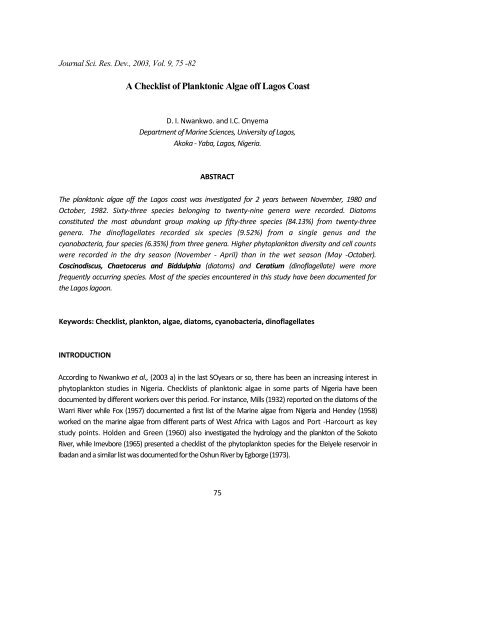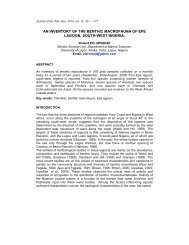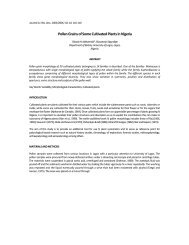A Checklist of Planktonic Algae off Lagos Coast - Jsrd.org
A Checklist of Planktonic Algae off Lagos Coast - Jsrd.org
A Checklist of Planktonic Algae off Lagos Coast - Jsrd.org
You also want an ePaper? Increase the reach of your titles
YUMPU automatically turns print PDFs into web optimized ePapers that Google loves.
Journal Sci. Res. Dev., 2003, Vol. 9, 75 -82<br />
A <strong>Checklist</strong> <strong>of</strong> <strong>Planktonic</strong> <strong>Algae</strong> <strong>of</strong>f <strong>Lagos</strong> <strong>Coast</strong><br />
D. I. Nwankwo. and I.C. Onyema<br />
Department <strong>of</strong> Marine Sciences, University <strong>of</strong> <strong>Lagos</strong>,<br />
Akoka ‐ Yaba, <strong>Lagos</strong>, Nigeria.<br />
ABSTRACT<br />
The planktonic algae <strong>of</strong>f the <strong>Lagos</strong> coast was investigated for 2 years between November, 1980 and<br />
October, 1982. Sixty‐three species belonging to twenty‐nine genera were recorded. Diatoms<br />
constituted the most abundant group making up fifty‐three species (84.13%) from twenty‐three<br />
genera. The din<strong>of</strong>lagellates recorded six species (9.52%) from a single genus and the<br />
cyanobacteria, four species (6.35%) from three genera. Higher phytoplankton diversity and cell counts<br />
were recorded in the dry season (November ‐ April) than in the wet season (May ‐October).<br />
Coscinodiscus, Chaetocerus and Biddulphia (diatoms) and Ceratium (din<strong>of</strong>lagellate) were more<br />
frequently occurring species. Most <strong>of</strong> the species encountered in this study have been documented for<br />
the <strong>Lagos</strong> lagoon.<br />
Keywords: <strong>Checklist</strong>, plankton, algae, diatoms, cyanobacteria, din<strong>of</strong>lagellates<br />
INTRODUCTION<br />
According to Nwankwo et al., (2003 a) in the last SOyears or so, there has been an increasing interest in<br />
phytoplankton studies in Nigeria. <strong>Checklist</strong>s <strong>of</strong> planktonic algae in some parts <strong>of</strong> Nigeria have been<br />
documented by different workers over this period. For instance, Mills (1932) reported on the diatoms <strong>of</strong> the<br />
Warri River while Fox (1957) documented a first list <strong>of</strong> the Marine algae from Nigeria and Hendey (1958)<br />
worked on the marine algae from different parts <strong>of</strong> West Africa with <strong>Lagos</strong> and Port ‐Harcourt as key<br />
study points. Holden and Green (1960) also investigated the hydrology and the plankton <strong>of</strong> the Sokoto<br />
River, while Imevbore (1965) presented a checklist <strong>of</strong> the phytoplankton species for the Eleiyele reservoir in<br />
Ibadan and a similar list was documented for the Oshun River by Egb<strong>org</strong>e (1973).<br />
75
76 D. I. Nwankwo. and I. C. Onyema<br />
More recently Nwadiaro and Ezefili (1986) listed the phytoplankton <strong>of</strong> New Calabar River while Opute<br />
(1991) presented a checklist <strong>of</strong> the phytoplankton flora <strong>of</strong> the Warri / Forcados estuary. Nwankwo<br />
(1988a) has also presented a checklist <strong>of</strong> the Nigerian marine macroalgae from Tarkwa bay West mole<br />
whereas Nwankwo (1988b) complied a list <strong>of</strong> the planktonic algae <strong>of</strong> the <strong>Lagos</strong> Lagoon.<br />
Additionally, a checklist <strong>of</strong> algae in the plankton from the Bonny River have received attention by Chindah<br />
and Pudo (1991) and Kadiri (1999) also presented a list and distribution <strong>of</strong> phytoplankton in some coastal<br />
waters <strong>of</strong> Nigeria with <strong>Lagos</strong>, Ondo, Delta, Bayelsa and Rivers states as key sampling points for the<br />
survey. Further to this, Nwankwo et al., (2003a) also published an additional list to the already<br />
existing checklist for the <strong>Lagos</strong> Lagoon (Nwankwo, 1988b) after ISyears <strong>of</strong> additional phycological<br />
investigations in the region.<br />
Presently there is no published work on a checklist <strong>of</strong> phytoplankton species found in the sea <strong>of</strong>f the<br />
<strong>Lagos</strong> coast. The knowledge <strong>of</strong> these species and their role as foundational aquatic food chain <strong>org</strong>anism<br />
in the marine ecosystem particularly in the neritic waters <strong>of</strong>f <strong>Lagos</strong> cannot be understated. The<br />
aim <strong>of</strong> this project was to investigate the phytoplankton assemblage <strong>of</strong> the <strong>Lagos</strong> coast and hence<br />
document a checklist <strong>of</strong> encountered species.<br />
DESCRIPTION OF STUDY AREA<br />
The coastline <strong>of</strong> Nigeria boarders 853km <strong>of</strong> the Atlantic Ocean and is interrupted by a series <strong>of</strong><br />
estuarine entries to the sea. The coastal area <strong>of</strong> South‐western Nigeria, more specifically, is a<br />
meandering network <strong>of</strong> lagoons that angle approximately 45° to the prevailing south‐westerlies wind<br />
and parallel to the coastline (Hill and Webb, 1958; Webb, 1958; Ibe, 1988; Nwankwo, 2004b) (Figure<br />
1). Rainfall in this area though concentrated in one season is bimodal with peaks in June and<br />
September/October. This area is influenced by the semi‐diurnal tidal regime experienced along<br />
the entire West African coastal region (Webb, 1958; FAO, 1969; Olaniyan, 1969).<br />
The dominant ocean currents operating within the area include the Benguella, Guinea, Equatorial, and<br />
the Equatorial counter currents. High energy waves are generated within this region that<br />
continually pound the <strong>Lagos</strong> shoreline at an angle.
A <strong>Checklist</strong> <strong>of</strong><strong>Planktonic</strong> <strong>Algae</strong> <strong>of</strong>f <strong>Lagos</strong> <strong>Coast</strong><br />
MATERIALS AND METHODS<br />
Phytoplankton sample collection<br />
Phytoplankton samples for the two years <strong>of</strong> study were collected with the aid <strong>of</strong> a 55/j.m standard<br />
plankton net and the training vessel, 'Federal Argonaut'. The vessel is about 200m long and has an<br />
engine capacity <strong>of</strong> 425 hp and collections were made between latitudes 3°27'E and 3° 29'S and longitudes<br />
6° 17' Nand 16° 24^N for the study. On each occasion the net was tied to the vessel and towed at low<br />
speed (< 4knots) for Smins. All samples were collected in 250ml plastic containers with screw caps and<br />
preserved in 4% unbuffered formalin prior to biological analysis.<br />
Figure 1: Hydrological map <strong>of</strong> <strong>Lagos</strong> showing study area<br />
Phytoplankton analysis<br />
In the laboratory one drop, five different times for each sample after concentration to lOmls were<br />
investigated at different magnification (X15, X100 and X400) using a Zeiss binocular microscope with a<br />
calibrated eye piece. The microtransect drop count method described by Lackey (1938) and employed by<br />
Nwankwo (1984) was used. Since each drop is O.lml, results on abundance were multiplied by 10 to<br />
give the values as numbers <strong>of</strong> <strong>org</strong>anisms per ml. Appropriate texts were used to aid identification<br />
(Subramanyan, 1946; Smith, 1950; Hendey, 1958,1964; Desikachary, 1959; Foged, 1966; Wimpenny,<br />
1966; Patrick and Reimer, 1966, 1975; Nwankwo, 1990, 2004a). To<br />
77
78 D. I. Nwankwo. andl.C. Onyema<br />
enhance diatom identification, sub‐samples <strong>of</strong> the original samples were acid cleaned using a<br />
mixture <strong>of</strong> H2SO4 and HNO3 acids.<br />
RESULTS<br />
For the two year survey a total <strong>of</strong> sixty‐six species <strong>of</strong> phytoplankton were recorded. The diatoms were<br />
the most prominent group with a total <strong>of</strong> fifty‐three species (84.15%) from twenty‐three genera.<br />
Frequently occurring genera include Coscinodiscus (12 taxa), Chaetocerus (8 taxa), Biddulphia (6<br />
taxa) and Grammatophora (3 taxa). The din<strong>of</strong>lagellate were the second more prominent group<br />
with a total <strong>of</strong> six species (9.52%) from a sole genus (Ceratium). The cyanobactena recorded four<br />
species (6.35%) from three genera. Oscillatoria, Phormidium and Trichodesmium were the genera<br />
encountered.<br />
Table 1: A <strong>Checklist</strong> <strong>of</strong>planktonic algae <strong>of</strong>f the coast <strong>of</strong> <strong>Lagos</strong>.<br />
Bacillariophyceae<br />
Actinophycus splendens (Schadbolt) Ralfs<br />
Asterionella gracialis Cleve & Muller Bacillaria<br />
paxillifer (O. F. Muller) Hendey Biddulphia<br />
aurita (Lyngbe) Brebission Biddulphia<br />
longricruris Greville Biddulphia mobilense<br />
(Bailey) Grunow Biddulphia regia Schultze<br />
Biddulphia rhombus (Ehrenberg) Wm Smith<br />
Biddulphia sinensis Greville Cerataulina<br />
bergoni (Cleve) Hendey Chaetoceros<br />
atlanticum Cleve Chaetoceros coarctatum<br />
Lauder Chaetoceros decipens Cleve<br />
Chaetoceros densum Cleve Chaetoceros<br />
didymus Ehrenberg Chaetoceros diversum<br />
Cleve Chaetoceros laciniosum Shurt<br />
Chaetoceros peruvianum Brightwelli<br />
Corethron criphilum Castracane Coscinodiscus<br />
asteromphalus Ehrenberg Coscinodiscus<br />
centralis Ehrenberg Coscinodiscus eccentricus<br />
Ehrenberg
A <strong>Checklist</strong> <strong>of</strong> <strong>Planktonic</strong> <strong>Algae</strong> <strong>of</strong>f <strong>Lagos</strong> <strong>Coast</strong><br />
Coscinodiscus gigas Ehrenberg Coscinodiscus<br />
granni Gough Coscinodiscus janischii A. Schmidt<br />
Coscinodiscus jonesianus (Greville) Ostenfeld<br />
Coscinodiscus lineatus Ehrenberg Coscinodiscus<br />
marginatus Ehrenberg Coscinodiscus oculus‐<br />
iridis Ehrenberg Coscinodiscus radiatus<br />
Ehrenberg Coscinodiscus stellaris Ehrenberg<br />
Detonula schroderi P. Bergon Ditylum<br />
brightwelli (West) Grunow Donkinia sp<br />
Eucampia cornuta Ehrenberg Grammatophora<br />
marina (Lyngbye) Kutzing Grammatophora<br />
sourieri Amosse Grammatophora sp<br />
Gyrosigma wansbeckii (Donkin) Cleve<br />
Hyalodiscus stelliger Bailey Hyalodiscus sp<br />
Hemidiscus harmannianus (Greville) Mann<br />
Thallassionema longissima (Grunow)<br />
Cyanophyceae<br />
Oscillatoria margatifera (Kutzing) Gomont<br />
Oscillatoria nigro‐viridis Thwaites Phormidium<br />
fragile (Meneghini) Gomont Trichodesmium<br />
thiebautii Gomont<br />
Dinophyceae<br />
Ceratium furca Ehrenberg Ceratium<br />
fusus Ehrenberg Ceratium<br />
macroceros Ehrenberg Ceratium<br />
massilense Ehrenberg Ceratium<br />
pulchellum K<strong>of</strong>oid Ceratium tripos<br />
(O.F.M.) Nitzsch<br />
79
80 D. I. Nwankwo. andl.C. Onyema<br />
DISCUSSION<br />
From the study there were comparatively fewer numbers <strong>of</strong> species for this study viz a viz other<br />
seasonal microalgal investigations in the coastal waters <strong>of</strong> Nigeria (Nwankwo, 1988b; Nwankwo et al.,<br />
2003, Onyema et al., 2003). Comparatively, higher abundance and diversity <strong>of</strong> planktonic algal species<br />
was recorded for the dry season (November ‐ April) than in the wet season (May ‐October). For<br />
instance species <strong>of</strong>Coscinodiscus, Chaetocerus, Biddulphia, Ditylum and Ceratium occurred more<br />
frequently in the dry season. A good number <strong>of</strong> the species encountered for this study have been<br />
recorded in marine situations elsewhere (Subramanyan, 1946, Newell and Newell, 1966; Wimmpenny,<br />
1966).<br />
Furthermore, the occurrence <strong>of</strong> din<strong>of</strong>lagellates species such as Ceratium furca, Ceratium fusus,<br />
Ceratium tripos and diatoms such as Chaetoceros convolutus, Cerataulina bergonii and<br />
Coscinodiscus centralis among other diatoms have also been reported to impose anoxia, clogging and<br />
damage <strong>of</strong> fish gills under bloom conditions in the same region (Nwankwo et al., 2003 a,b).<br />
The occurrence <strong>of</strong> the cyanobacteria Trichodesmium thiebautii was observed only in warm,<br />
stratified, relatively nutrient poor waters in the dry season. Nwankwo et al., (2003b) have reported that<br />
Trichodesmium thiebautii blooms in the coastal waters <strong>of</strong> south‐western Nigeria and clogging <strong>of</strong> fishing<br />
nets in bloom conditions have also been reported in the same region for this cyanobacterium<br />
Species <strong>of</strong> Oscillatoria and Phormidium encountered during the study are likely immigrant forms from<br />
land brought in with floodwaters during the rains.<br />
REFERENCES.<br />
Chinda, A.C and Pudo, J. (1991). "A preliminary checklist <strong>of</strong> algae found in plankton <strong>of</strong> Bonny<br />
River in Niger Delta, Nigeria". Fragmflor. Geobot.36 (1): 112‐126.<br />
Desikachary, T.V. (1959). Cyanophyta. Indian Council <strong>of</strong> Agric. Research, New Delhi. 686pp. Egb<strong>org</strong>e,<br />
A.M.B. (1973). "A preliminary check list <strong>of</strong> the phytoplankton <strong>of</strong> the Oshun river,<br />
Nigeria". Freshwater Biol. 4: 177 ‐ 191. Foged, N. (1966). "Freshwater diatoms from Ghana".<br />
Biologiske Skrifter Det Kongelige Dansfe<br />
Videnskabernes Selskab. 15(1). 160pp F.A.O. (1969). Fisheries Survey in the Western and Mid‐<br />
Western Regions <strong>of</strong> Nigeria. FAO/Sf:<br />
74/NIR 6. 142pp. Fox, M. (1957). "A first list <strong>of</strong> marine algae from Nigeria". Jour. Linn. Soc.<br />
London. LV (365):<br />
615‐631. Hendey, N.I. (1958). "Marine diatoms from West African Ports". Journal <strong>of</strong> Royal<br />
Microscopic,<br />
Society. 77: 28‐88.
A <strong>Checklist</strong> <strong>of</strong><strong>Planktonic</strong> <strong>Algae</strong> <strong>of</strong>f <strong>Lagos</strong> <strong>Coast</strong><br />
Hendey, N.I. (1964). An introductory account <strong>of</strong> the smaller algae <strong>of</strong> British coastal waters. Part<br />
5. Bacillariophyceae (diatoms) London. N.M.S.O. 317pp. Hill, M.B. and Webb, J.E. (1958). "The ecology<br />
<strong>of</strong> <strong>Lagos</strong> lagoon II. The topography and physical<br />
features <strong>of</strong> the <strong>Lagos</strong> harbour and <strong>Lagos</strong> lagoon". Philosophical Transaction <strong>of</strong> Royal<br />
Society, London. 241:307‐417. Holden, M.J. and Green, J. (1960). "The hydrology and plankton <strong>of</strong> River<br />
Sokoto". J. anim. Ecol.<br />
29: 65 ‐ 84.<br />
Ibe, A. C. (1988). <strong>Coast</strong>line erosion in Nigeria. University Press, Ibadan. 217pp. Imevbore, A.M.A. (1965). "A<br />
preliminary checklist <strong>of</strong> the planktonic <strong>org</strong>anism <strong>of</strong> the Eleiyele<br />
Reservoir, Ibadan, Nigeria". Journal <strong>of</strong> West Africa Science Association. 10: 156 ‐ 160. Kadiri, M.O.<br />
(1999). "Phytoplankton distribution in some coastal waters <strong>of</strong> Nigeria". Nigeria<br />
Journal <strong>of</strong> 'Botany.12 (1): 51 ‐ 62. Lackey, J.B. (1938). The manipulation and counting <strong>of</strong><br />
river plankton and changes in some<br />
<strong>org</strong>anism due to formalin preservation. U.S. Public Health Reports. 63, 2080‐2093. Mills, F.W. (1932).<br />
"Some diatoms from Warri, Southern Nigeria". J.R.Micro. Soc., 52:383 ‐ 394. Newell, G.E and Newell, R.C.<br />
(1966). Marine plankton: a practical guide. Revised Edition.<br />
Hutchinson London. 225pp. Nwadiaro, C.S. and Ezefili, E.O. (1986). "A preliminary checklist <strong>of</strong> the<br />
phytoplankton <strong>of</strong> New<br />
Calabar river, lower Niger delta, Nigeria". Hydrobiol. Bull. 19: 133 ‐ 138 Nwankwo D. I. (1984).<br />
"Seasonal Variation <strong>of</strong> Phytoplankton <strong>of</strong> <strong>Lagos</strong> Lagoon and the Adjacent<br />
Sea inRelation to EnvironmentalFactors"..P/i.,D77zesi's, University <strong>of</strong> <strong>Lagos</strong>, Akoka. 447pp. Nwankwo, D.<br />
I. (1988a). "A <strong>Checklist</strong> <strong>of</strong> Nigerian Marine <strong>Algae</strong> (Tarkwa Bay)". Nigerian<br />
Journal <strong>of</strong> Botany 1: 47‐50. Nwankwo, D.I. (1988b). "A preliminary checklist <strong>of</strong> planktonic algae in<br />
<strong>Lagos</strong> lagoon Nigeria".<br />
Nigerian Journal <strong>of</strong>Botanica I Applied Sciences.. 2: 73‐85. Nwankwo, D.I. (1990). "Contribution to the<br />
Diatom flora <strong>of</strong> Nigeria. Diatoms <strong>of</strong> <strong>Lagos</strong> lagoon<br />
and the adjacent sea". Nig. J. Bot. 3: 53‐70. Nwankwo, D.I. (2004a). The Microalgae: Our<br />
indispensable allies in aquatic monitoring and<br />
biodiversity sustainability. University <strong>of</strong> <strong>Lagos</strong> Press. Inaugural lecture series. 44pp. Nwankwo, D.I.<br />
(2004b). A Practical Guide to the Study <strong>of</strong> <strong>Algae</strong>. JAS Publishers, <strong>Lagos</strong>. Nigeria. Nwankwo, D.I; Onyema, I.C.;<br />
Adesalu, T.A.; Olabode, R.J.;Osiegbu, G.O. and Owoseni,<br />
T.I. ( 2003a). "Additions to a preliminary check‐list <strong>of</strong> planktonic algae in <strong>Lagos</strong> lagoon,<br />
Nigeria". Journal <strong>of</strong> Science Technology and Environmental. 3(1). 8‐12. Nwankwo, D.I., Onyema, I.C.<br />
and Adesalu, T.A.(2003b). " survey <strong>of</strong> harmful algae in coastal<br />
waters <strong>of</strong> south‐western Nigeria". Journal <strong>of</strong> Nigerian Environmental Society. 1(2): 241 ‐<br />
246. Olaniyan, C.I.O. (1969). "The seasonal variation in the hydrology and total plankton <strong>of</strong> the<br />
lagoons <strong>of</strong> South West, Nigeria". Nigerian Journal <strong>of</strong> Science. 3(2): 101‐119.<br />
81
82<br />
D. I. Nwankwo. and I. C. Onyema<br />
Onyema, I.C., Otudeko, O.G. and Nwankwo, D.I. (2003). "The distribution and composition <strong>of</strong><br />
plankton around a sewage disposal site at Iddo, Nigeria". Journal <strong>of</strong> Scientific Research<br />
Development..7: 11‐24. Opute, F.I. (1991). "A checklist <strong>of</strong> the freshwater, brackish andmarine<br />
phytoplankton <strong>of</strong> the Warn<br />
/Forcados estuaries <strong>of</strong> southern Nigeria". Nig. J. Bot. 4: 227 ‐ 254. Patrick, R. and Reimer, C.W.<br />
(1966). "The diatoms <strong>of</strong> the United States exclusive <strong>of</strong> Alaska and<br />
Hawaii (Vol. 1)". Monogr. Acad. Nat. Sci. Philadelphia. 686pp. Patrick, R. and Reimer, C.W.<br />
(1975). "The diatoms <strong>of</strong> the United States exclusive <strong>of</strong> Alaska and<br />
Hawaii (Vol. 2, part 1)". Monogr. Acad. Nat. Sci. Philadelphia. 213pp. Smith, G.M. (1950). The<br />
fresh‐water algae <strong>of</strong> the United States. McGraw‐Hill, London.719pp. Subrahmanyan, R.(1946). "A<br />
systematic account <strong>of</strong> the marine plankton diatoms <strong>of</strong> the Madras<br />
coast". Proceedings <strong>of</strong> the Indian Academy <strong>of</strong> Science. 24: 85 ‐ 197. Vanlandingham, S.L. (1982).<br />
"Guide to the identification and environmental requirements and<br />
pollution tolerance <strong>of</strong> freshwater blue‐green algae (cyanophyta)". U.S. Environmental<br />
Protection Agency, EPA ‐ 60. Webb, J.E. (1958). "The Ecology <strong>of</strong> <strong>Lagos</strong> lagoon. 1: The<br />
lagoons <strong>of</strong> the Guinea <strong>Coast</strong>".<br />
Philosophical Transaction Royal Society London. Ser B: 241‐283. Wimpenny, R.S. (1966). The<br />
plankton <strong>of</strong> the sea. Faber and Faber Limited, London. 426pp.




